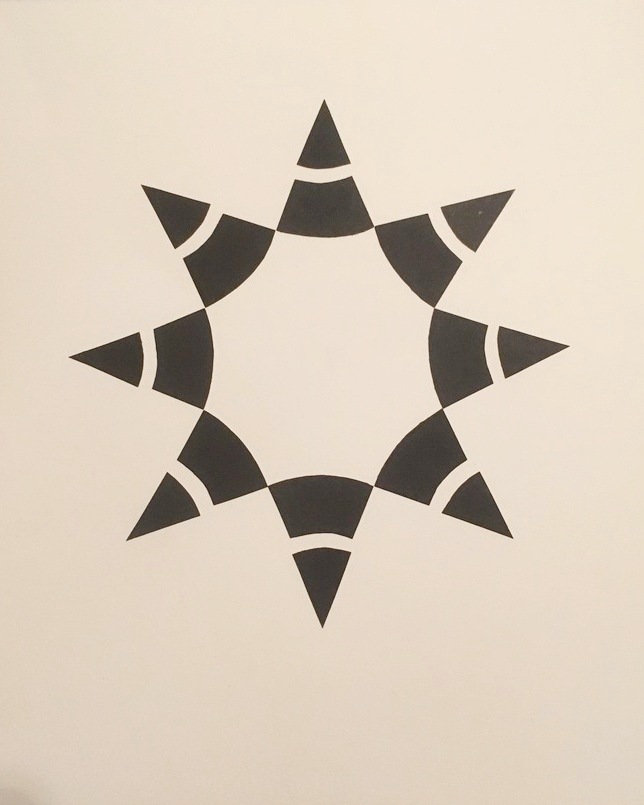Project Objectives
Develop visual understanding of the differences between subject matter and form.
Intentionally transform a representational design into an abstract or non-representational design to convey Content.
Develop visual understanding of the Elements of Design Shape & Space and their characteristics.
Develop visual understanding of the Principle of Organization Balance.
Project Description
In this project you will continue to exercise ways to abstract from Subject Matter while focusing on Form. You will explore figure/ground relationships through the usage of shape and space to evoke content. You will also use the Principles of Organization Balance and to help you achieve the desired content.
You will develop the project based on the Japanese design concept called Nōtan (濃淡), which observes the relationship and placement of light and dark shapes in the composition translating shape & space into flat shapes on a two-dimensional surface. Nōtan is traditionally presented in paint, ink, or cut paper, but it is relevant to a host of modern-day image-making techniques, such as lithography in printmaking, and rotoscoping in animation (1).
Project Considerations
You will create three (3) abstract (non-representational) Nōtan compositions.
The shapes should be either organic/biomorphic or geometric
One composition should have Asymmetric Balance | The sides of the composition are not equal but bare the same visual weight
One composition should have Symmetric Balance | Two sides of the composition are equal.
One composition should have Radial Balance | All four sides of the composition are equal.
Are there shapes created in both the figure and ground creating figure-ground reversal?
Are there any shapes or negative spaces that are not activated within your composition?
Has the final design been executed in a professional manner?
Designs should utilize the designated materials with care, effort, and attention to detail. This includes proper mounting to Bristol Board.
Required Materials
6" x 6" Artagain Black Paper 14” x 17” Bristol Board Sketchbook HB Pencil Eraser Ruler Scissors Artist Tape Glue Stick
Step-by-step Directions
Part 0: Prepare the artAgain Paper
Cut down the Artagain Black Paper to 6 in x 6 in.
You need three (3) 6 in x 6 in sheets of paper.
Part 1: Asymmetrical Balance Nōtan Composition
Create the first Nōtan composition:
Step 1: Research Asymmetrical Balance.
Step 2: Sketch the shapes respecting the Asymmetrical Balance. Intentionally decide if your shapes are organic or geometric.
Step 3: Cut the shapes using scissors. Aim to create inner shapes. Intentionally decide if your shapes are organic or geometric.
Step 4: Mount the cut shapes on 14”x17” piece of Bristol board. Make sure the design is centered on the board.
Step 5: Paste the larger shape on the Bristol Board using the glue stick and making sure you are leaving enough space around the glued shape to paste the other shapes.
Part 2: Symmetrical Nōtan Composition
Create the second Nōtan composition:
Step 6: Research Symmetrical Balance.
Step 7: Sketch the shapes respecting symmetrical Balance. Intentionally decide if your shapes are organic or geometric.
Step 8: Cut the shapes using scissors. Aim to create inner shapes. Intentionally decide if your shapes are organic or geometric.
Step 9: Mount the cut shapes on 14”x17” piece of Bristol board. Make sure the design is centered on the board.
Step 10: Paste the larger shape on the Bristol Board using the glue stick and making sure you are leaving enough space around the glued shape to paste the other shapes.
Part 3: Radial Nōtan Composition
Create the third Nōtan composition:
Step 11: Research Radial Balance..
Step 12: Sketch the shapes respecting Radial Balance. Intentionally decide if your shapes are organic or geometric.
Step 13: Cut the shapes using scissors. Aim to create inner shapes. Intentionally decide if your shapes are organic or geometric.
Step 14: Mount the cut shapes on 14”x17” piece of Bristol board. Make sure the design is centered on the board.
Step 15: Paste the larger shape on the Bristol Board using the glue stick and making sure you are leaving enough space around the glued shape to paste the other shapes.
CRAFTSMANSHIP is extremely important for each of your designs and is part of the grading criteria. Do not fold, bend, crease, smudge, tear your artworks! Always take great care when creating each design and then put directly into your portfolio case.
What is Craftsmanship? Care in construction and finishing; demonstration of skill and knowledge of processes; attention to detail. The quality of design and work shown in something that is made by hand.
Project Delivery
Created one asymmetrical composition and mounted on Bristol board.
Created one symmetrical composition and mounted on Bristol board.
Created one radial composition and mounted on Bristol board.
Grading Criteria
This project is worth 3 points.
Project's Grade Rubric
Craftsmanship & Materials: The final designs have been executed in a professional manner utilizing the proper materials.
The designated materials are intentionally utilized with care, effort, and attention to detail - cut, pasted, and properly mounted to Bristol Board.
Composition & Elements of Design: The composition utilizes the whole picture plane and has a strong visual flow containing 50% black and 50% white shapes. The design is abstracted from subject matter, shapes are interesting and complement each other, and successfully use convex and concave shapes to create figure/ground relationships.
Principles of Organization | Asymmetrical: One design presents asymmetrical balance.
Principles of Organization | Symmetrical: One design presents symmetrical balance.
Principles of Organization | Radial: One design presents radial balance.

